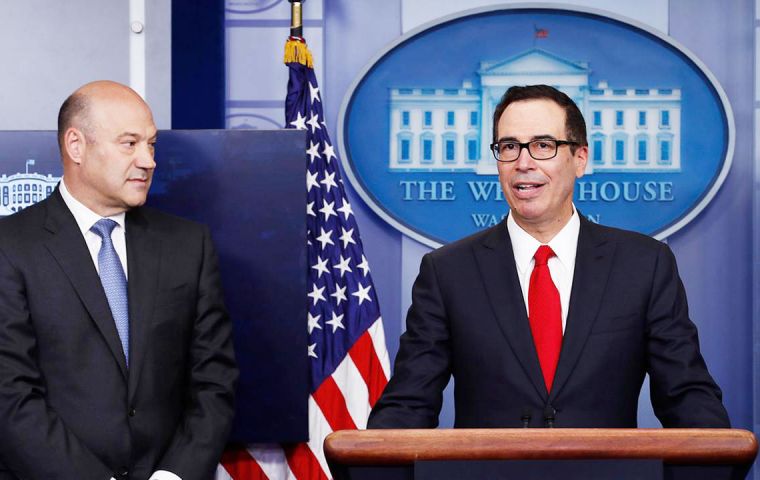MercoPress. South Atlantic News Agency
Trump announces plan to lower taxes; Wall Street cautious, Democrats call it a handout to the wealthy
 Secretary Steven Mnuchin, and White House chief economic adviser Gary Cohn rolled out the plan at the White House
Secretary Steven Mnuchin, and White House chief economic adviser Gary Cohn rolled out the plan at the White House  At a signing ceremony Trump said: “it’s a great plan” adding “it’s going to put people back to work.”
At a signing ceremony Trump said: “it’s a great plan” adding “it’s going to put people back to work.”  “President Trump’s tax proposal does not do nearly enough for working families and small businesses in this country,” top Democrat Rep. Richard Neal (Mass.) said
“President Trump’s tax proposal does not do nearly enough for working families and small businesses in this country,” top Democrat Rep. Richard Neal (Mass.) said President Donald Trump administration on Wednesday presented a sweeping plan to lower tax rates for individuals and businesses, saying it would create the biggest tax cut in United States history. However US markets slid at the close after the Trump administration outlined the tax cut plan and Democrats described it as a handout to the wealthy that would expand the deficit.
The Dow Jones Industrial Average closed down 20.68 points, or 0.10%, at 20,975.44, and the S&P 500 shaved off 1.16 points, or 0.05%, to 2,387.45 The Nasdaq Composite was down 6.52 0.27 points at 6,025.23.
The plan would cut the top personal income tax rate from 39.6% to 35% and double the standard deduction for taxpayers while eliminating all credits and deductions aside from those for mortgage interest and charitable giving.
On the business side, the plan would lower the tax rate for corporations and most small businesses to 15%, more than halving the current 35% corporate rate. It would also eliminate the estate tax and the alternative minimum tax.
Secretary Steven Mnuchin, and White House chief economic adviser Gary Cohn rolled out the plan and although president Trump did not attend the briefing, later in the day he praised it at a signing ceremony.
“It’s a great plan,” Trump said. “It’s going to put people back to work.”
The outline presented by the White House was short on details but represented a significant milestone in the tax reform debate, with the administration laying out broad parameters for what it wants to see in legislation.
Support from the White House will be critical if Republicans are going to achieve their goal of overhauling the tax code for the first time since 1986.
The proposal released Wednesday carries over several elements of Trump’s campaign tax plan while sharing some similarities with the blueprint that House Republicans released last year. Both proposals call for eliminating all individual deductions, except those for mortgage interest and charitable giving, along with moving to a “territorial” tax system that doesn’t cover American companies’ foreign earnings.
During his campaign, Trump adopted the House Republican blueprint’s idea of collapsing the seven tax rates for individuals into three: at 12%, 25% and 33%. Trump tweaked those rates slightly in the latest plan, instead floating three tax brackets of 10%, 25% and 35%.
Trump’s tax reform principles also did not discuss some of the provisions in the House GOP plan designed to pay for lowering tax rates. Notably, the White House did not endorse a border-adjustment proposal to tax imports and exempt exports.
Retailers, who have been leading the charge against the border-adjustment proposal, were encouraged by the omission.
“The president has been clear that among his goals are simplifying the tax code and providing relief to middle-income Americans. The border adjustable tax does neither,” said Brian Dodge, a spokesman for the Retail Industry Leaders Association. “Instead, it is outrageously complex and will force American families to pay more for the things they need.”
But the White House made clear it wasn’t ruling out border adjustment entirely. Treasury Secretary Steven Mnuchin said on Wednesday morning that the administration doesn’t support the proposal “in its current form” but continues to have discussions with lawmakers about modifications.
Republican lawmakers, business groups and prominent conservatives generally praised the proposal, arguing that it would provide relief for individuals, boost the economy and make businesses more competitive.
However Democrats blasted Trump’s plan, calling it a giveaway to the wealthy that would expand the deficit. They expressed disappointment that the plan did not include infrastructure spending.
“President Trump’s tax proposal does not do nearly enough for working families and small businesses in this country,” Rep. Richard Neal (Mass.), the top Democrat on the Ways and Means Committee, said in a statement.
But one aspect of Trump’s plan that is certain to prove controversial is the proposal to eliminate the state and local tax deduction. The deduction elimination has been a part of a number of recent GOP tax plans, including the House GOP plan, and would raise a significant amount of revenue.
Tax experts said that it’s important for Trump to personally sell the proposal in the future if he wants tax reform to succeed.
“The only way you get tax reform done is with the enthusiastic support of the president of the United States,” said Howard Gleckman, a senior fellow at the Urban-Brookings Tax Policy Center.




Top Comments
Disclaimer & comment rulesCommenting for this story is now closed.
If you have a Facebook account, become a fan and comment on our Facebook Page!